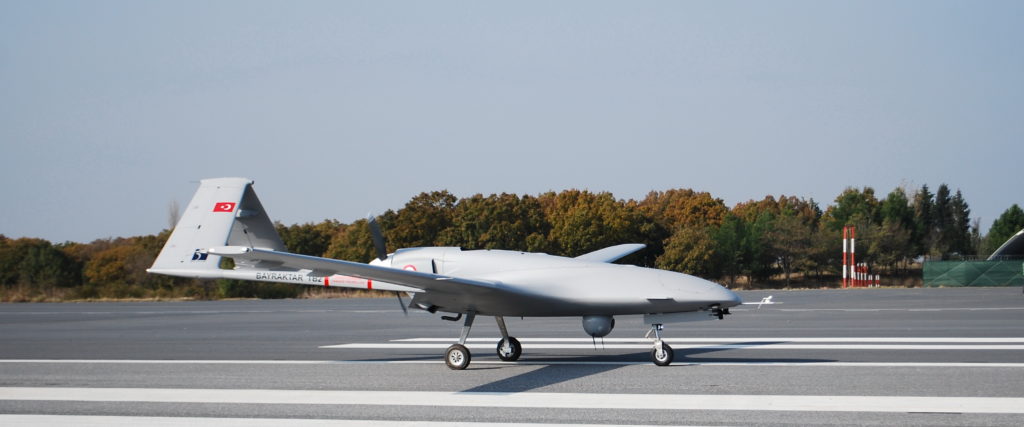
Bayraktar TB2.
“The achievements of the TB2 drones are the first signs of the impact of unmanned systems in naval warfare… drone warfare will be an integral part of naval warfare in the near future.”
Turkish-made Bayraktar TB2 drones are playing a force multiplier role for Ukraine in its war with Russia. According to several Turkish defense experts, the way Ukrainian forces have used these drones in the current conflict are marking new chapters in the use of drones in naval warfare and possibly in anti-submarine warfare. While it is too early to tell if TB2s are changing the trajectory of the conflict, they have given Ukrainian forces a significant advantage and have had at least a psychological effect on both sides so far.
Turkey’s TB2 drones came under the spotlight early in the conflict when the Ukrainian military released video footage of them destroying Russian tanks. More recently, the TB2 emerged as a key tool in the sinking of the Russian cruiser Moskva, although it is not exactly clear what role it played. As the first accompanying passage from Nikkei Asia notes, one theory claims that Ukrained used TB2s to distract the Moskva when it launched anti-ship missiles. Another theory claims Ukraine used TB2s to pinpoint the exact location of the cruiser in the Black Sea, enabling precision strikes against it.
In early May, the Ukrainian Air Force staged a raid on the Russian force occupying Ukraine’s strategic Snake Island. TB2 drones played an important role by waging a defense-suppression campaign over the island, knocking out at least three air defense systems, two Russian patrol boats, and a landing craft along the shore. As the second passage by Turkish naval expert Tayfun Özberk notes, the attack on Russian patrol boats and a landing craft marked the first successful neutralization of naval vessels by an uncrewed system. Özberk claims this is the start of a new era in the use of drones in naval warfare. During this same raid, the TB2 drones also destroyed a Russian Mi-8 helicopter. As the final passage from an interview with Turkish defense expert Özgür Ekşi notes, this may also suggest a new chapter in military doctrine. Ekşi claims that if the Mi-8 helicopter was hovering in the air when it was hit, this would indicate that the TB2 drone can also calculate the height/altitude of targets, adding a third dimension to its usage. He also claimed this would be a game changer in anti-submarine warfare, since anti-submarine helicopters working to detect and track submarines would be at risk of an attack by a smart munition from a drone while hovering in air.
Sources:
Sinan Tavşan, “Turkish-made drones likely involved in Moskva sinking,” Nikkei Asia, 18 April 2022. https://asia.nikkei.com/Politics/Ukraine-war/Turkish-made-drones-likely-involved-in-Moskva-sinking
“Reports that Turkish TB2 drones were involved in the attack either as a distraction for Moskva or as location spotter of Moskva are both quite possible,” said Can Kasapoglu, director of the security and defense studies program at the Center for Economics and Foreign Policy Studies (EDAM), Turkish think tank.
Source: Tayfun Özberk, “Russian Serna-Class LCU Becomes the New Victim of TB2 Drone,” Naval News, 8 May 2022. https://www.navalnews.com/naval-news/2022/05/russian-serna-class-lcu-becomes-the-new-victim-of-tb2-drone/
TB2s’ recent attack on the Raptor-class patrol boats on 02 May 2022 marked the first successful neutralization of naval vessels by an uncrewed system. The assault on the Serna class landing craft marks the second one. In both attacks, TB2s used MAM-L smart munitions manufactured by the Turkish Roketsan company.
…
The achievements of the TB2 drones are the first signs of the impact of unmanned systems in naval warfare. Unmanned systems that provide not only ISR support but also strike operations will provide tactical flexibility to decision-makers on the naval battlefield. Because such systems can conduct missions without risking human lives, and thanks to their capabilities that are growing daily, drones will become a suitable replacement for manned systems. As a result, drone warfare will be an integral part of naval warfare in the near future.
Source: Tolga Özbek chats with Özgür Ekşi, “TB2 Ukrayna’da gemi ve helikopter vurdu, sirada ne var? (TB2 struck ship and helicopter in Ukraine, what next?),” TolgaOzbek.com via YouTube, 9 May 2022. https://www.youtube.com/watch?v=qo-eKSL0A7A&list=WL&index=39&t=12s
On 8 May, images appeared on the internet of a Ukrainian Bayraktar TB2 Drone blowing up a Russian Mi-8 helicopter as troops landed on Snake Island… If this helicopter was in the hovering position, [this means that] a TB2 hit a flying platform, which is a success and a new page in military doctrine… This means that these drones can also calculate the height of targets. Until now, we talked about two dimensions, land and water. But now, it can calculate height/altitude, which means it can also hit a flying target. This is a new thing for air platforms.
Image Information:
Image: Bayraktar TB2.
Source: Bayhaluk via Wikimedia, https://commons.wikimedia.org/wiki/File:Bayraktar_TB2_Runway.jpg
Attribution: CC BY-SA 4.0

